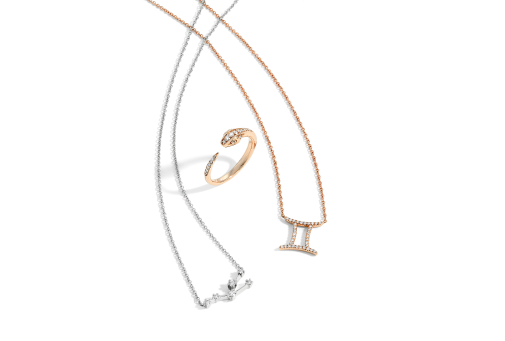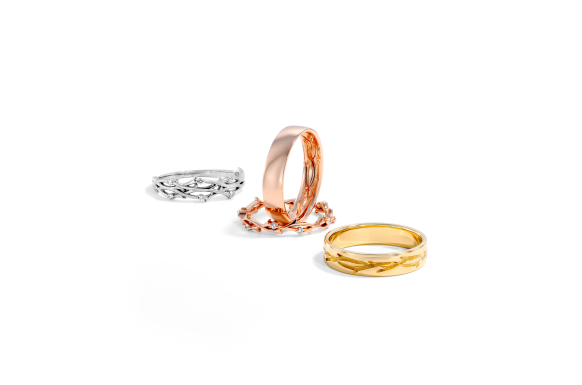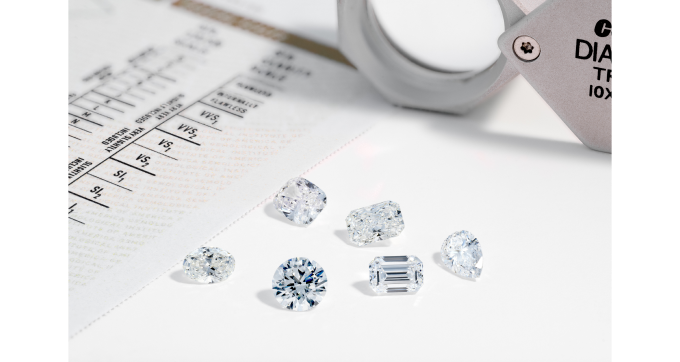So, you’re ready to buy a diamond but don’t know how to tell a shiny rock from a priceless gem. Well, you’re in luck, friend.
While all polished diamonds are worth something, not all of them are worth your time or your hard-earned money. Diamond grading provides a guide that anyone, from diamond dealer to blushing bride, can use to determine the value of an individual diamond.
But how important is it to grab a graded diamond, and how do you read a certification anyway? Let’s get into it.
A, B, C, Diamond
What exactly is diamond grading anyway? Simply put, it’s an industry-wide standardized process of determining a diamond's quality.
Labs like GIA, IGI, and AGS (just to name a few) run tests on each individual diamond. The quality of each stone is broken down into several categories. These categories can each be seen on the diamond report.
The overall scores of each category (things like clarity, color, and more) combine to tell us how valuable each stone is.
Grade Guardians
So, who’s actually doing all this diamond grading? While technology is beneficial and used throughout the process, the actual grading is done by people.
These highly trained diamond graders study each stone for color, clarity, and cut. Not to mention all of the tiny details in between. This is an incredibly detail-oriented process. At least two diamond graders check each stone to ensure an accurate and impartial grade.
An unbiased opinion is crucial, so each stone is also given a number as it comes into the lab. Graders never know where the stones came from. This anonymity provides another level of assurance of the equality of each diamond and its grading process.
Study Sesh
Just how does that meticulous grading get done? Each stone is carefully studied by experts, one gem at a time.
For color, each stone is compared to a set of actual round brilliant diamonds that have been set up as a color scale. These are called masterstones.
Clarity is also measured by expert graders, this time by close and detailed observation. This is done using a 10x magnification loupe and a microscope. Inclusions and blemishes are mapped on a diamond chart. This shows the type of inclusion and its precise location.
During this step, graders also look for treatments that may have been done to improve the diamond artificially. This will also be noted in the report.
Here are a few inclusions they are looking for.
• Pinpoint inclusions or tiny black spots.
• Diamond cavities, which are small holes within the diamond
• Feather inclusions are tiny cracks inside or on the surface of the diamond.
The combination of location, size, and the number of inclusions, as well as whether or not they can be seen with the naked eye, all affect the diamond's clarity grade.
Check your work
Gemologists always check their work. A diamond is graded for color and clarity by one gemologist, then passed to another for a second opinion. This second grader forms their opinions entirely independently from the first.
These reports are compared and finalized when a consensus is reached on the diamond's quality. If things don’t quite add up, a third opinion may be called in from a senior gemologist. This ensures the most accurate grade possible for each diamond.
Does it Pass the Test?
Do you need to buy a certified diamond? Well, it’s certainly recommended.
Diamond certification ensures the buyer and seller both know the fair value of the stone. An uncertified diamond might look great, but you have no way of knowing the actual value. This could lead to you overpaying or going home with a lousy diamond.
Certification means you know exactly what you are getting, and diamond dealers know exactly what they’re selling. So it’s definitely to the benefit of both parties to snag that certification.
POP Quiz
What are diamonds graded for, and how do you know which diamond is the best?
Choosing a diamond can be overwhelming. Starting with a budget and having a style in mind are great jumping-off points. But grading is where you can really narrow down what it is you want in a stone.
The most common things to look for, and easiest to understand, are called the 4C’s.
C’s Across the Board
Cut is one of the most important factors when buying a diamond
• A well-cut diamond will be sparkly and bright
• A poorly cut stone will be dark and dull
• Only round brilliant stones are graded for cut
• This grade is based on symmetry, facet position, polish, shine, and culet size.
Diamond color is graded on a scale.
• D represents colorless, Z light color
• It is not essential to buy a completely colorless stone
• A G-H color stone will be less expensive and still appear colorless
• A diamond's fluorescence can also affect the color. Blue fluorescence can make a yellow stone appear more colorless
• The fewer inclusions, the more valuable
• But it is not necessary to buy a completely flawless stone, only an eye-clean one.
• The location of these inclusions is also a key factor in visibility
• Inclusions near the table will be easily visible
• Inclusions near the edge can be a structural concern
• A certification will mark the location and type of inclusions
Carat Weight is the specific unit of measure
• Carat weight was developed for gemstones and diamonds
• Very precise measurement
• One carat is 0.2 grams or 0.007 ounces
• The slightest variation can mean hundreds of dollars depending on the quality
• A diamond's weight does not necessarily tell you its size as this can vary slightly due to other factors.
The combination of all of these factors shows us the diamond’s quality. Understanding the quality (and which areas are most important for your needs) can help you go home with a better diamond for your budget.
The Final Presentation
Diamond certification levels the playing field. It ensures that buyers and sellers alike know the quality and fair value of all those tiny shinies.
The grading process can seem complicated. But when you know what to look for, a good cut, an eye-clean stone, and a colorless appearance, finding the right rock can be as easy as ABC. Or VVS in this case.






